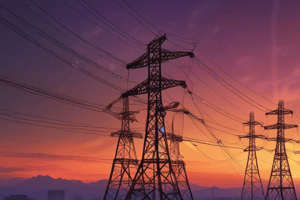Podcast
Questions and Answers
What is a characteristic of an ungrounded system?
What is a characteristic of an ungrounded system?
- Low equipment damage (correct)
- High fault current levels
- No natural capacitance to ground
- Rapid fault isolation
Why are ungrounded systems sometimes used in industrial plant systems?
Why are ungrounded systems sometimes used in industrial plant systems?
- To minimize production costs
- To reduce the risk of transient overvoltages
- To reduce equipment damage
- To minimize interruptions of expensive production processes (correct)
What happens to the voltage triangle during a phase-to-ground fault on an ungrounded system?
What happens to the voltage triangle during a phase-to-ground fault on an ungrounded system?
- It becomes zero
- It becomes unbalanced and distorted
- It remains balanced and unchanged
- It shifts to a new position (correct)
What is the relationship between the distributed capacitive reactance values and the series reactance values in an ungrounded system?
What is the relationship between the distributed capacitive reactance values and the series reactance values in an ungrounded system?
What is a disadvantage of ungrounded systems?
What is a disadvantage of ungrounded systems?
What happens to the positive sequence network in an ungrounded system?
What happens to the positive sequence network in an ungrounded system?
What is the reason why Ia = 3I0 in the fault current calculation?
What is the reason why Ia = 3I0 in the fault current calculation?
What is the purpose of Ib and Ic currents in the system?
What is the purpose of Ib and Ic currents in the system?
What is the equivalent of X0C in industrial applications?
What is the equivalent of X0C in industrial applications?
What happens to the unfaulted phase-to-ground voltages when a phase-to-ground fault occurs?
What happens to the unfaulted phase-to-ground voltages when a phase-to-ground fault occurs?
What is the definition of the neutral point in a three-phase system?
What is the definition of the neutral point in a three-phase system?
Why is it impractical to use selective location of faults by protective relays in ungrounded systems?
Why is it impractical to use selective location of faults by protective relays in ungrounded systems?
Flashcards are hidden until you start studying
Study Notes
Characteristics of Ungrounded Systems
- Ungrounded systems do not have a physical connection to the earth, minimizing ground fault currents.
- Voltage remains stable under normal conditions, as no path exists for ground current to flow.
Use in Industrial Plant Systems
- Often utilized in industrial settings to increase reliability, allowing continued operation during a single ground fault without immediate shutdown.
- Provides a safer environment as ground faults can be detected and addressed without system interruption.
Voltage Triangle during Phase-to-Ground Fault
- During a phase-to-ground fault, the voltage triangle shifts, causing the voltage of the unfaulted phases to increase while the voltage of the faulted phase drops to zero.
- The remaining phase voltages can increase to 1.73 times their normal value due to the ungrounded nature of the system.
Capacitive Reactance Relationship
- In an ungrounded system, distributed capacitive reactance values influence the system response but are separate from series reactance values.
- Distributed capacitive reactance helps maintain voltage stability and affects fault current magnitude during faults.
Disadvantages of Ungrounded Systems
- Vulnerable to transient overvoltages, which can damage equipment due to the accumulation of charge at the fault location.
- Continuous operation under fault conditions can lead to subsequent failures if faults are not addressed quickly.
Positive Sequence Network Behavior
- In the case of a ground fault, the positive sequence network remains unaffected as it continues to reflect the normal operating condition of the unfaulted phases.
Fault Current Calculation
- In fault current calculations, Ia (current during fault) equals three times I0 (zero sequence current) due to the summation of phase currents in the fault condition, reflecting how currents distribute in the network.
Purpose of Ib and Ic Currents
- Ib and Ic represent the current in the unfaulted phases, crucial for monitoring system stability and integrity during a fault event.
- These currents help assess the health of the system and inform decisions on corrective actions.
Equivalent of X0C
- X0C represents the zero-sequence capacitive reactance in industrial applications, significant for understanding how capacitive effects influence fault propagation and load behavior.
Phase-to-Ground Voltages during Fault
- When a phase-to-ground fault occurs, the unfaulted phase-to-ground voltages rise, leading to potential overvoltage issues for connected equipment.
- The faulted phase voltage drops, altering the balance of system voltages.
Definition of Neutral Point
- The neutral point in a three-phase system is the point where the three phases meet, usually employed for grounding to ensure safety and proper system operation.
Challenges with Protective Relays
- Selective location of faults via protective relays is impractical in ungrounded systems due to the indeterminacy of fault location and the system's tendency to remain operational despite faults.
- This complicates the ability to isolate faults without affecting system performance, requiring more complex monitoring and diagnostic strategies.
Studying That Suits You
Use AI to generate personalized quizzes and flashcards to suit your learning preferences.





